Spending a day going from Bamford to Hathersage via Stanage Edge
7th June 2020Not only does this trip report the last of a trilogy describing three different visits to the Peak District during the autumn of 2017, but it also is the last one from that year that still needed writing. 2018 is next and 2019 follows, though my hill wandering appears to have stopped mid-year for a number of reasons that I can recall readily at this moment. Still, these were different times compared to what we are going through at the moment, so it is good to be transported. Hopefully, we can enjoy more like them again sooner rather than later. Old memories are most useful, but the collection always needs augmenting.
After days spent around the Great Ridge and Ladybower Reservoir, another idea prompted me to devote one to the countryside around Stanage Edge, and that is what this trip report describes. It was a return after a break extending back to the early years of the century, there were several day trips to this part of the world, and they brought home to me how hard it can be to find a marked right of way on pathless ground. There are times when general direction of travel is all you need, so map and compass work without so much regard for legality is then the way to proceed.
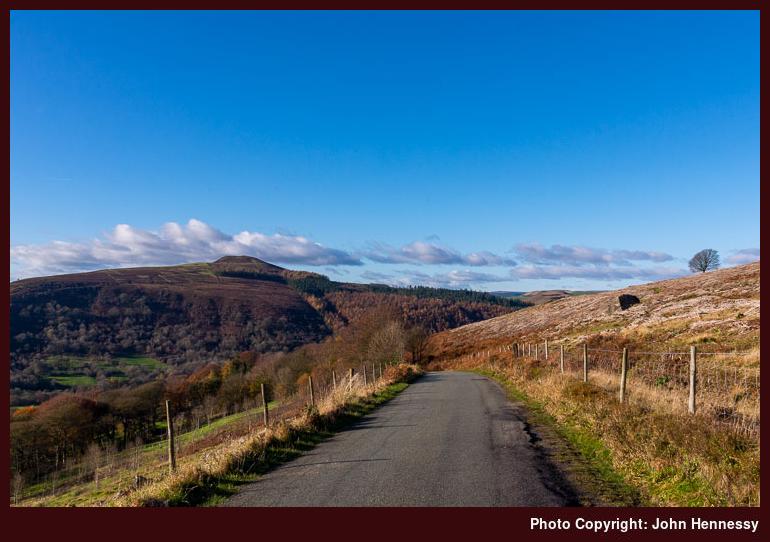
That meant there was an experiment ahead of me on arriving in Bamford, though I picked my way along lanes at the start. Designs on going up a bridleway through Bamford Clough were dashed by signs indicating excavations as part of maintenance works on the electricity supply network. Others were more courageous (or foolhardy, depending on what lay ahead of them) while I stuck with tarmac tramping for a little longer before I found an alternative footpath leading me from Ashopton Road to New Road, thus achieving a not dissimilar outcome. Doing so might have granted me less restricted views of my surroundings, though, and one of those appears above.
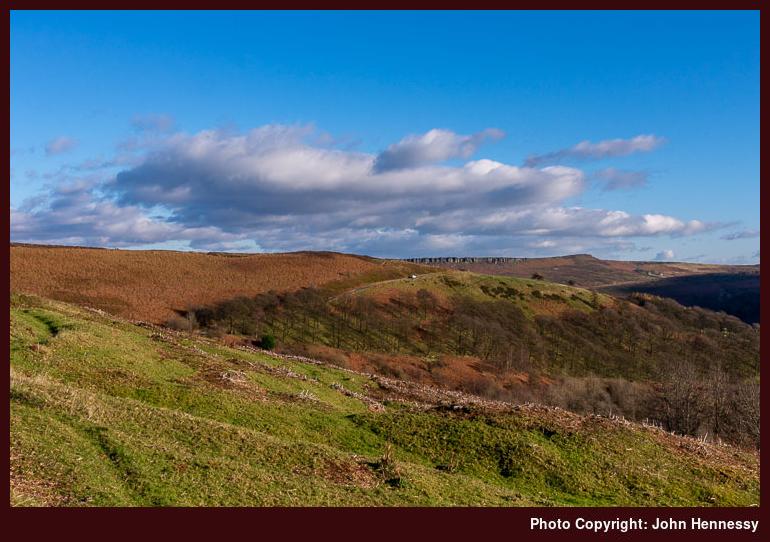
Eventually, I found the desired path that would lead me away from New Road and into the wilder emptier countryside that I planned to revisit after such a long absence, especially since it was to grant me ample amounts of the solitude that I so needed at the time. It also was bringing some challenging route finding that I wanted to use for testing GPS navigation on a fine crisp clear sunny day, albeit one with a stiff chilling wind to give the endeavour more of a wintry feel.
Going through abandoned quarry works that nature was reclaiming proved a little too intricate for dependence on a GPS receiver, but added map consultation and backtracking to salve any qualms at lack of route adherence were sufficient to achieve the required combination of peace of mind and onward progress.
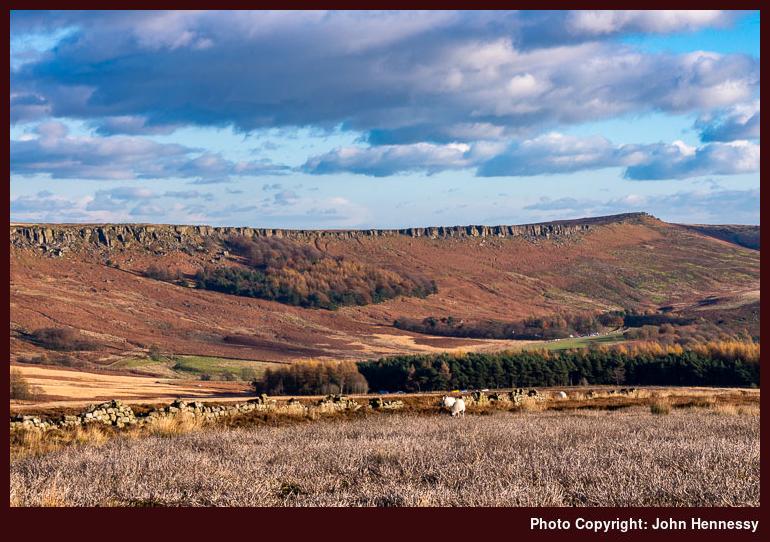
Eventually, it was time to cross pathless moorland, with some useful features like walls being so broken down that their visibility and usefulness get diminished. That though sends my mind back to a laden with memories of unguided cross-country tramping in failing light that eventually landed me in Bamford after scaring me more than a little. That day, banks of heather started to look like walls, so that is why their appearance on an OS map may not give you the handrails that you need. This was no saunter for those who depend on human landmarks for way finding guidance.
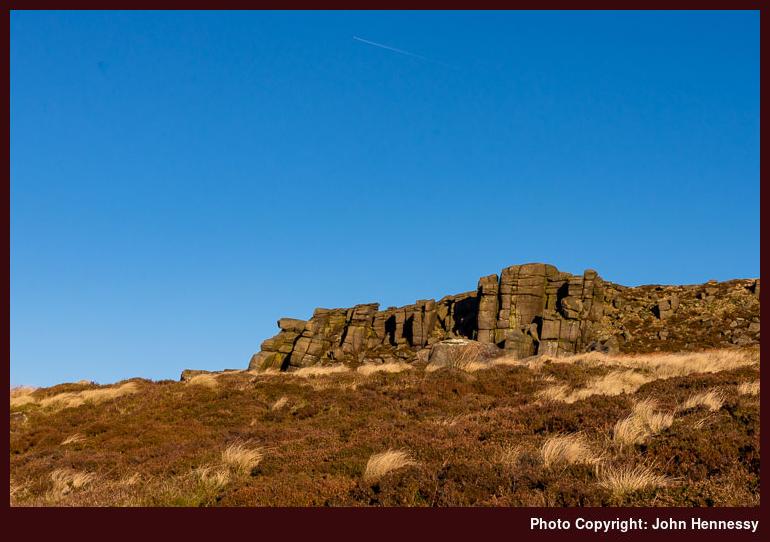
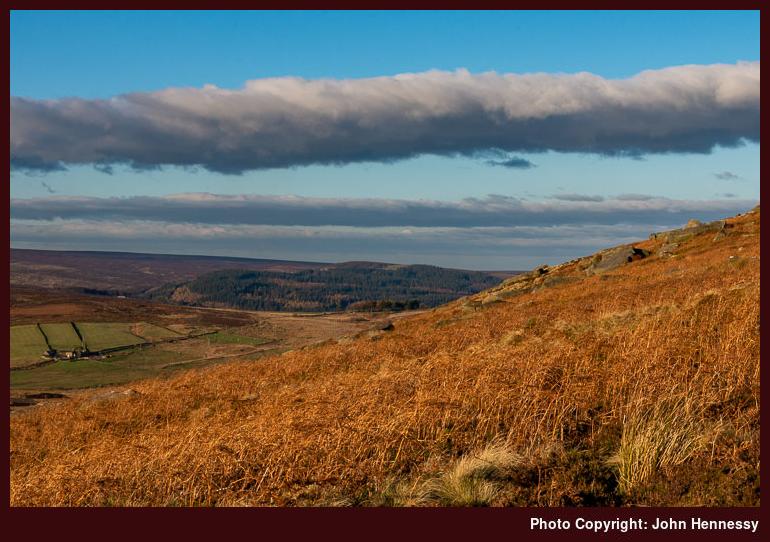
Such mirages were not to present themselves as I used the GPS to find the right line on the ground as I continued towards Stanage Edge over ground that at times had the consistency of a soggy bog. Neither waist-high rushes together, or dead bracken were to drive me from my course as I made my way from Bamford Moor to Moscar Moor and then onto Stanage End. The chill of the way was inescapable, so headgear and gloves were pressed into service, along with the warm fleece that I was wearing.
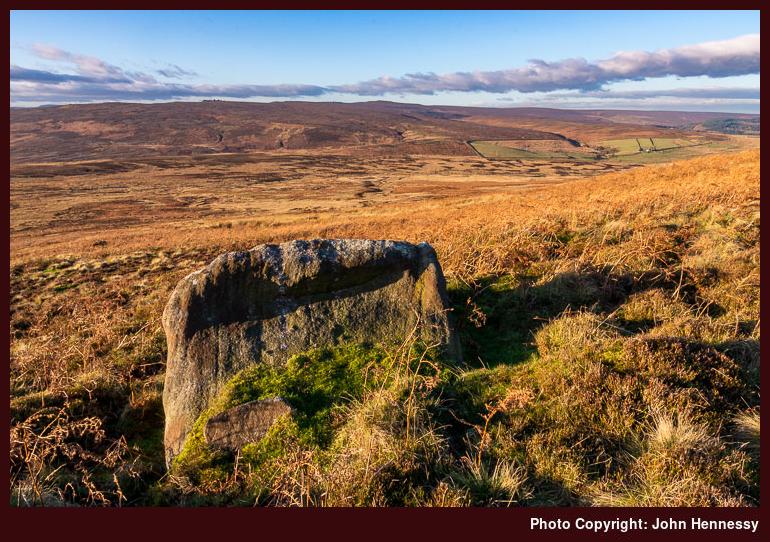
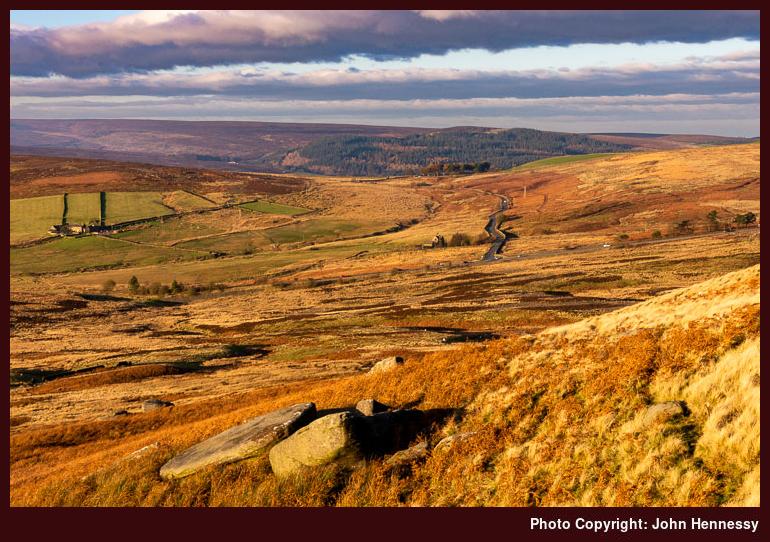
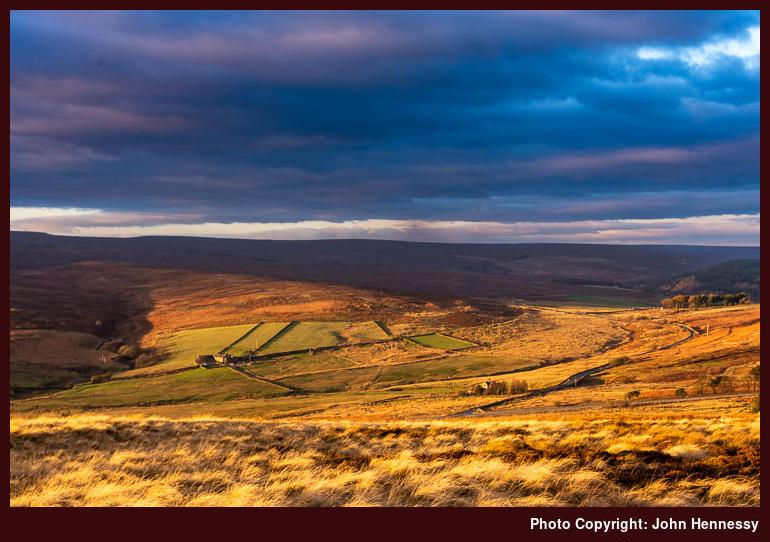
Though offering plenty of solitary hiking, the endeavour brought a time penalty since it was clear that it was nearer the end of the hours of daylight than was ideal. While the supposed proximity of the urban outskirts of Sheffield offered a possible alternative, I stuck with a return to Hathersage that took me past High Neb and along Stanage Edge itself. Light was declining all the while as I traipsed the trail, with some parts being boggier than others. None did anything to take away from the satisfaction of the stroll.
As the day approached the onset of its gloaming, I left Stanage Edge and the route of the Sheffield County Walk, to drop onto a byway that would lead me towards Dennis Knoll. As I did so, climbers were coming away from crags where they had spent time on what was a sunny day, one that lured out many an outdoors enthusiast. It was as if I were in the midst of other outdoor lovers at either end of my walk.
After Dennis Knoll, I resolved to stay on the lane descending all the way into Hathersage as some insurance against the looming loss of daylight with its attendant need for use of a head torch to light one’s way. There are times when things need to be kept simple, though it was only on the outskirts of Hathersage itself that I recall losing all daylight. Finding my way through the village after recovering from a minor route deviation, I was at its train station in plenty of time before the next train to Manchester, so I was repeating what had happened in Bamford the previous Sunday when I missed a train by mere minutes. A two-hour wait was avoided (a new timetable halved service frequency) so I could begin my journey home after a satisfying day laden with good memories.
Travel Arrangements
Outbound train journey from Macclesfield to Bamford followed by a return journey from Hathersage to Macclesfield with both having changes of train at Manchester.
A November day spent around Ladybower Reservoir
26th May 2020If it not for other intrusions, there could have been many an account from previous years making their appearances on here in an effort to clear a backlog. Some even might have thought it to be a retrospective like what Cairngorm Wanderer is doing, but that would be the wrong impression. Other missives might have share sunny moments from those previously limited opportunities for outdoor exercise like what Tarmachan Mountaineering has been doing. Alas, the worries of the moment overwhelmed me so it only is now that I am getting to flesh out this post for your perusal.
Thankfully, things are looking up a little now and the Spring Bank Holiday weekend saw me finding emptier corners for solitary relaxation. As you would expect, they turned up in some lesser frequented spots like around Pott Shrigley, Rainow, Higher Sutton, Bosley and North Rode. Each did me the world of good and there was no need to deal with human encounters given the added alertness required of the time in which we find ourselves.
Back in November 2017, none of this could be foreseen, and my task then was to recuperate and recharge after a stressful few years that life had sent me. When opportunities arose, I got out then and found quieter spots, but encounters with humanity had none of the edge that they do nowadays. The stroll described here had an immediate forebear and shared with it echoes of my early efforts at hill wandering. That came from my first-ever encounter with Ladybower Reservoir being on Holy Saturday in 2002 and this hike allowed plenty of time to admire that attractively placed body of water.
Returning to Easter 2002, the whole weekend had me spending a lot of time in the Peak District. It started on Holy Thursday when I tried out the Doctor’s Gate Footpath and a little part of the Pennine Way before returning to Glossop. Good Friday then was spent around Glossop and nearby Hadfield with a first visit to Longdendale, a place which appealed to me in spite of the electricity pylons. Though the collection of reservoirs hardly were so intrusive, I was left wondering how it might have appeared before they were built, and any appearances have done nothing to forestall return visits.
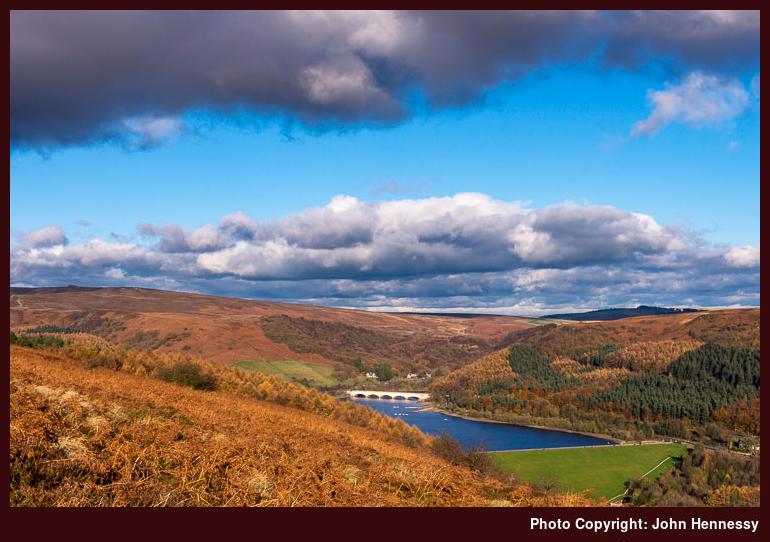
Though it similarly is a piece of human landscape engineering, that thought about wildness in Longdendale never really enters my mind when it comes to Ladybower Reservoir. The more natural appearance of the setting might have something to do with it and the absence of electricity pylons has to help as much as sights of steep-sided valleys with fingers of water reaching into them. At least, that is how it always seems to me whenever I think of this area and the photos accompanying this piece of writing may confirm that.
In many ways, the hike from November 2017 that is described here also reprised parts of a journey taken on a damp autumn day in another of the early years of this century. Then, the day improved as I continued all the way to Edale, but the 2017 counterpart had no such need as it remained sunny all the way until sunset.
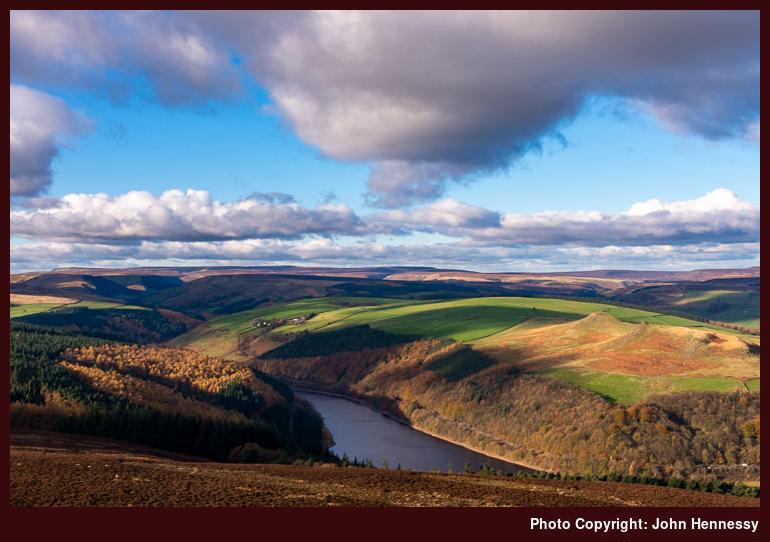
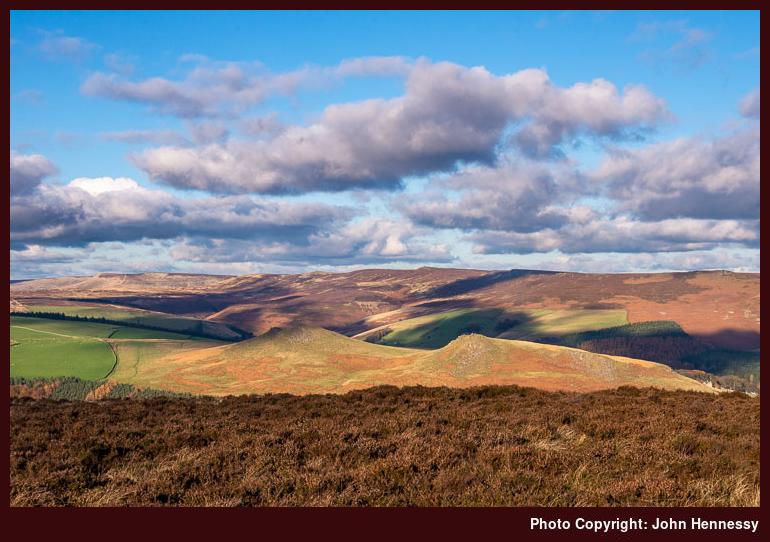
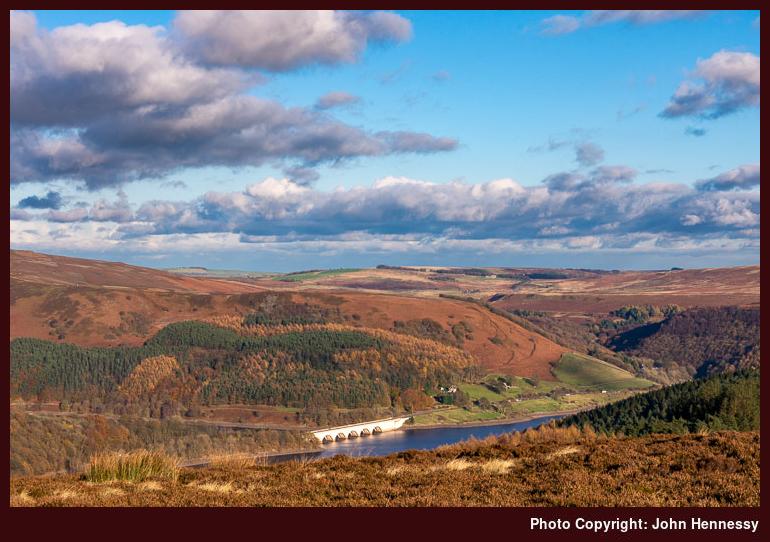
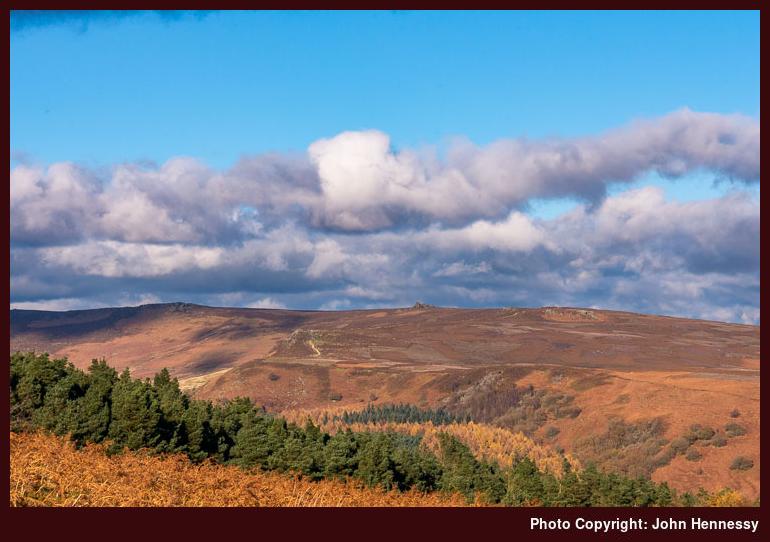
Both walks, though separated by more than a decade, took a similar course: on arriving at Hope train station, I started to make my way towards Win Hill. It may have been a place that I have visited on numerous but every time has been different. Such is the spread of seasons and variability of weather that it is difficult if not impossible to see it and its surroundings in the same kind of light more than once.
This time, my chosen route took me past Ryecroft and Thornhill Carrs on a variety of footpaths chosen to reach the top of Win Hill from the east. As I went over the top, the views all around and below me looked resplendent in the autumn sunshine. That I was not stopped in my track by the sights would be a surprise except that I had a circuit in mind before nightfall so that kept me moving, but the scenery was much enjoyed too, and the portfolio included views over Bamford and Yorkshire Bridge towards Stanage Edge as well as what you see above.
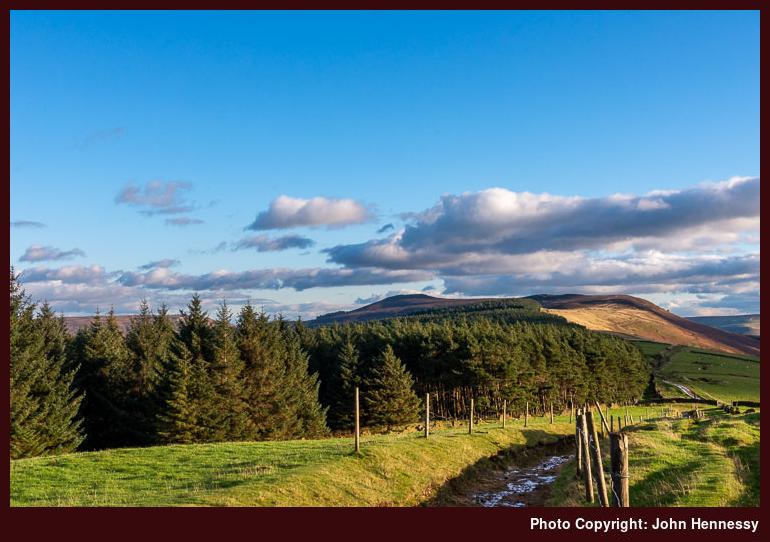
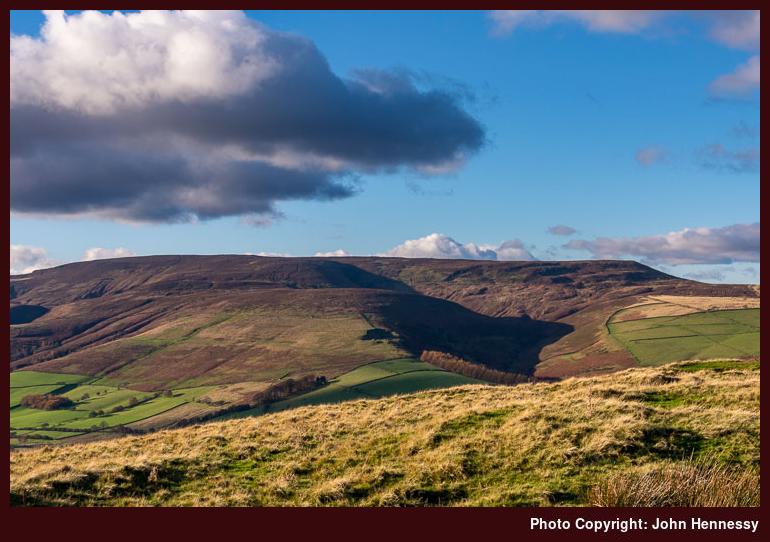
Once over the summit, I dropped down to Hope Cross, after which I started my descent to reach the River Ashop in the Woodlands Valley. From there, I continued to Ladybower Dam while enjoying the fading light of day and with my legs feeling less energetic than might have been desired. There was nothing for the task but keep going up and down as the track shadowed the shoreline. Along the way, a farmer was out to see his livestock while my journey continued.
At the dam, curiosity overcame any physical fatigue to see where the northern end of the Derwent Valley Heritage Way was to be found before retracing my steps and following it as far as the A6187. All the while, daylight faded to darkness and my head torch was used not only for navigating the gloaming but also in the dark of night, with a field being negotiated without rancour or error.
That added challenge may have cost me time on the way to Bamford train station though and I missed a train departure by a mere minute. The next day came sunny too, as if niggles come in pairs. However, the fact that I had enjoyed a superb day out was more than enough recompense for any forgettable irritations.
Travel Commentary
A day when the railways faced major disruptions hardly was one to travel from Macclesfield to Hope for a walk in the Dark Peak but no one was to know ahead of time and it did not delay my arrival in any event. As it happened, the journey home was slightly blighted by my missing a train at Bamford by less than a minute. That forced a wait of an hour for me, and getting back to Macclesfield from Manchester also was complicated by disruption elsewhere in the rail network. Even so, rail travel travails on that day have done nothing to deter me from trying again; these things ebb and flow.
An autumnal return to Derbyshire’s Great Ridge
3rd March 2020Late last year, I got to read Tim Flannery’s Europe: The First 100 Million Years. While this mainly is a palaeontological tale, it also features geological facets too and it fascinates me that Europe is in essence built from an island archipelago. Putting all that together probably gave us the hills and mountains that we enjoy today and I am left wondering if there are echoes of those former islands in the diversity of nations that exist throughout history and into our own time. The latter story leads to the politics of preceding and current ages of which I was reminded while reading Simon Jenkins’ A Short History of Europe: From Pericles to Putin. That was another of my recent reads, though I do limit my exposure to news of current developments since they tend to hurt just a bit.
It is not the latter that causes me to recount my recent reading but the book that I mentioned at the beginning. After all, I am recalling a hike from October 2017 that took in an area with limestone formations laid down by undersea creatures when it was in the tropics, such is the rearranging work of plate tectonics. Yorkshire may be better known for such things, but Derbyshire has its share too.
The autumn of 2017 was for me a time for recuperation and recovery and there were sunnier slots that lured me out and about. In contrast, its counterpart in 2019 was filled with near-continual wet weather, uncertainty and some big career decisions. 2020 has seen much of the same kind of weather already, but the work conundrum is on its way to getting resolved so I can look ahead a little more.
All of that lay in the future on the sunny Sunday in 2017 when I travelled to Hope after having whetted my appetite for hill wandering around Calderdale. Naturally, the weather lured others out and about too, with some being less prepared with knowledge than was ideal. Hearing the questions of some, it was if they were destined for a self-contained spot like Lyme Park rather than the more open country around the Hope Valley. Still, they made their own way after some guidance from others and our paths crossed later in the day.
My destination was somewhere that I reckon I had not trodden since a wet weather outing in December 2009: Derbyshire’s Great Ridge. This time, I walked it in the opposite direction from the two other occasions that I recall walking it; in addition to the 2009 encounter, there was a sunnier Sunday traverse earlier that decade (perhaps in 2002) and that took me over Win Hill too if I remember correctly.
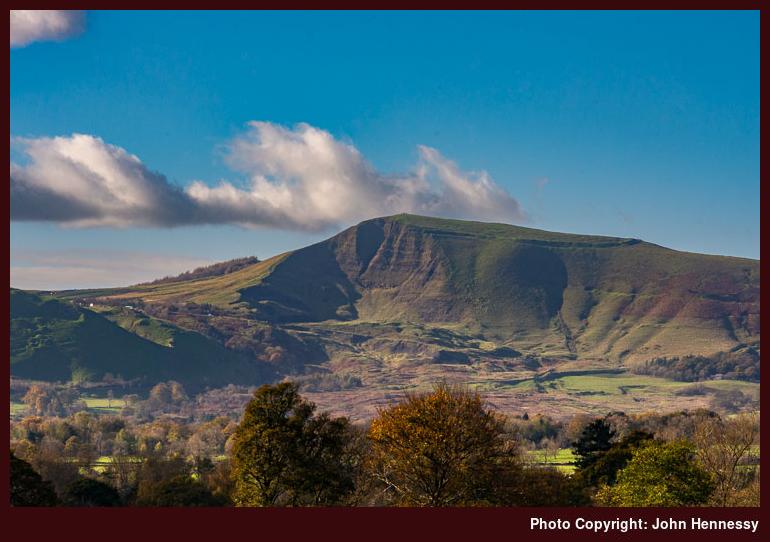
In some ways, it was that first-ever trip that lured me back again. Then, film photography was my means of recording any sights that I witnessed along the way and I fancied seeing what I could do with digital image capture. That was more than enough encouragement for the initial ascent of Lose Hill. Getting there from Hope train station took me around by Aston, Farfield Farm, Kirkhill Bridge and Losehill Farm. Sunny skies were my lot all the while, though greater cloudiness was to intrude later in the hike.
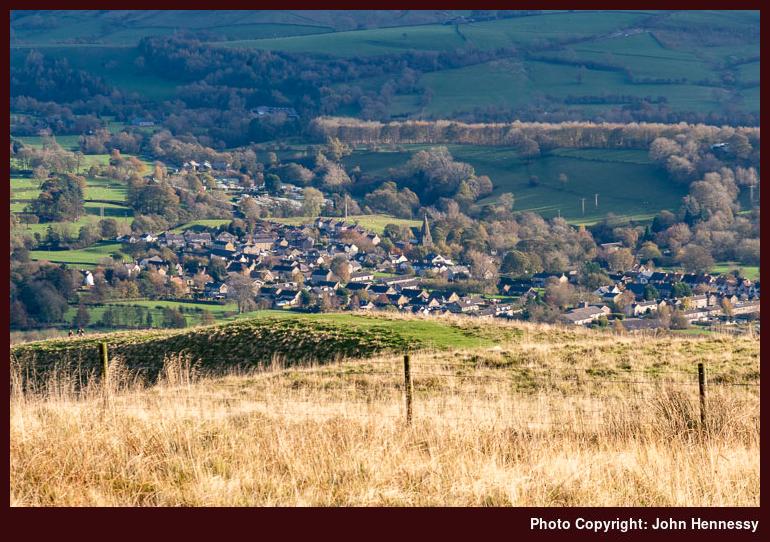
Once up on Lose Hill, I could see a lot more of what surrounded me, with Hope village and Win Hill being among these. The Great Ridge is a popular place to hike too so I needed to share the way with others as far as Win Hill when I took a quieter route on the way to Castleton. There still were plenty of moments of solitude though, so the trail did feel too crowded.
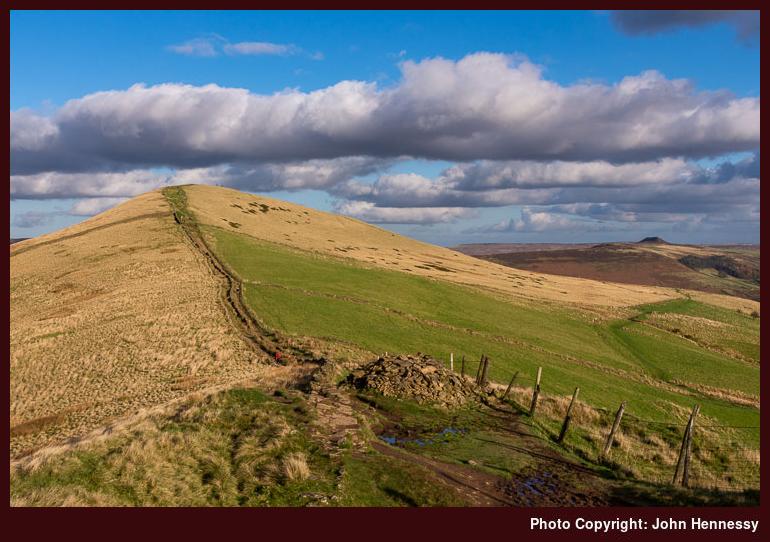
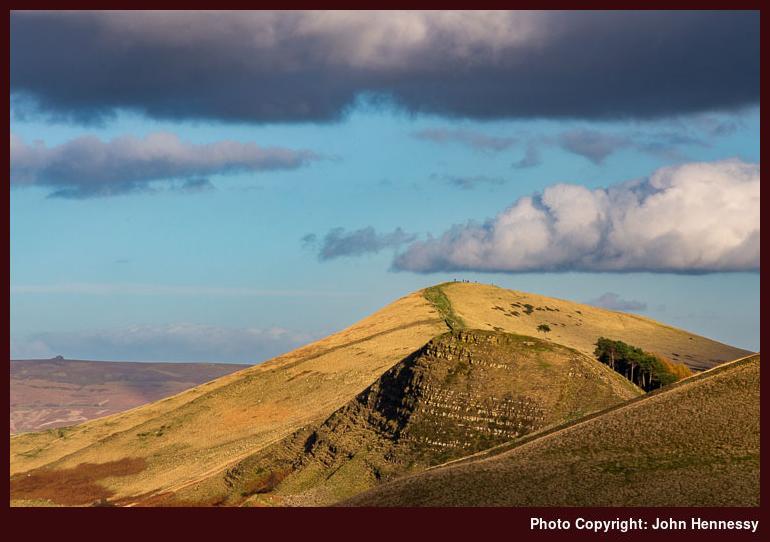
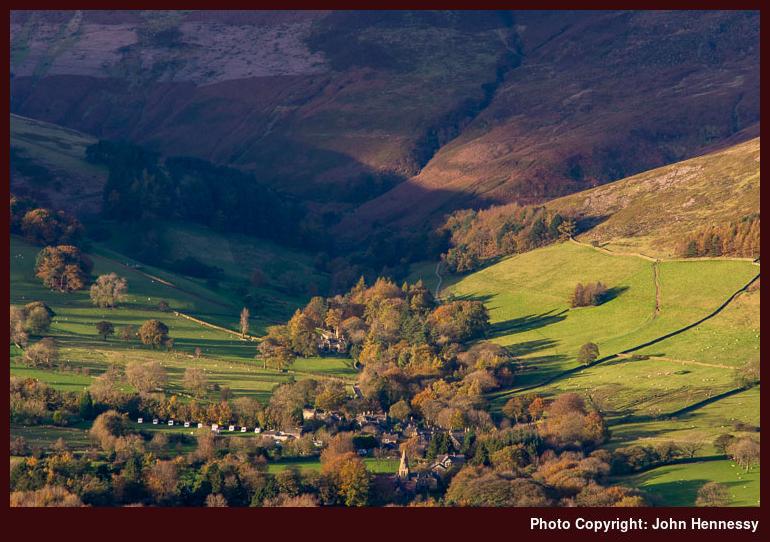
An easy-to-follow trail carried me along the undulating ridge and the pleasing sights in the autumn sunshine continued in spite of all the clouds in the sky. Views were there to take my eyes back along where I had come as well as peering where I had not been. Hope Valley and Edale were there to be surveyed as much as the hills that surrounded them. While there was much that was familiar, there also were a multitude of new sights to savour just as well.
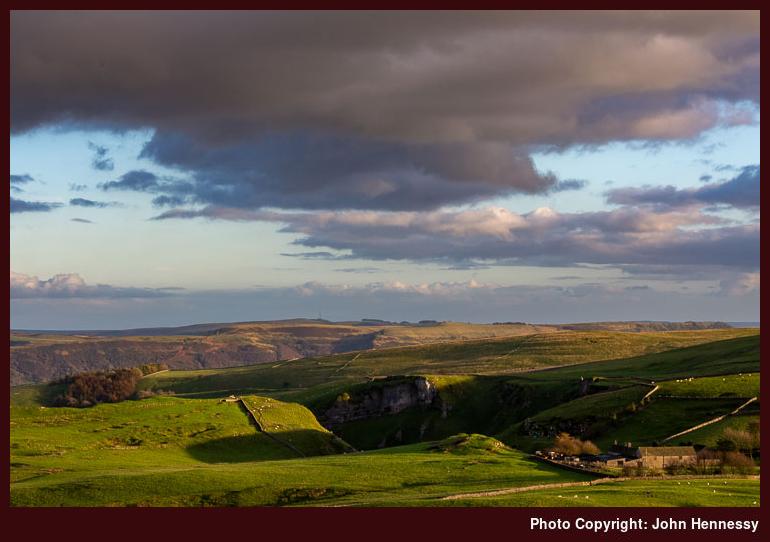
Mam Tor was a busy place as it so often is and it was not solely foot travellers who had found their way there, but paragliders also were about in numbers. As is often the case with honeypots, it takes going a little distance away to regain added solitude. Unusually, this act took me downhill instead of gaining some height as is so often the case.
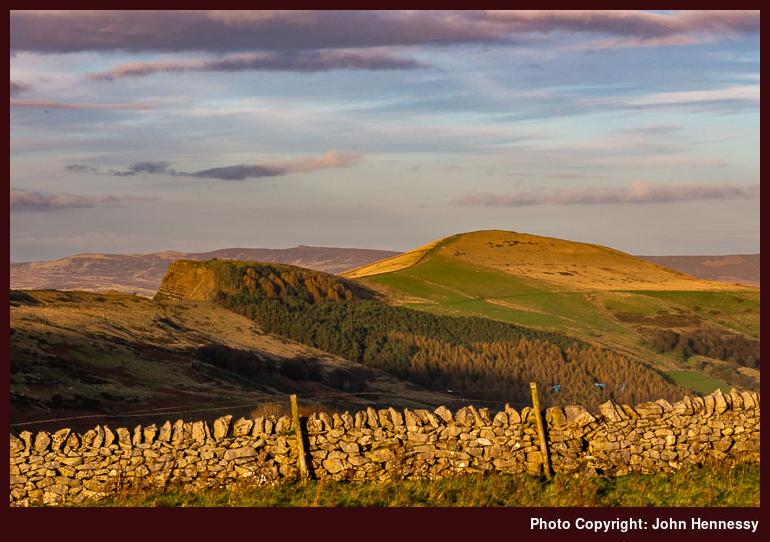
By now, I was en route towards Castleton as the sun declined ever more in the sky. The day was nearing its end, but the scenery was not to be plunged into darkness so quickly. My route was to take me over Windy Knoll and past Rowter Farm as I traipsed towards a rendezvous with the Limestone Trail for the last stretch of my outdoor strolling for the day.
It was to address a missing section of a hike from Buxton to Castleton on a summer’s day that lost the route of the Limestone Trail somewhere near Peak Forest. Getting the rest of the way took a spot of muddled navigation with general positioning being evident but greater precision was lost to me at the time. Still, I got to where I wanted to be albeit with a sense of dissatisfaction at its execution.
Even with declining light, there was none of that imprecision this time around and I dropped down into Cave Dale as intended. What slowed things was the need for careful progress along a track over limestone paving. That took its toll on already fatigued limbs but I got to Castleton without any sense of mishap. From there, a mix of bus and rail travel was to get me home again after a more than decent day out.
Travel Arrangements
Return train journey between Macclesfield and Hope with a change in Manchester Piccadilly. Bus journey from Castleton to Hope.
Autumnal and springtime encounters with both Parkhouse Hill and Chrome Hill
16th July 2019Sometimes, places get two visits before I get around to writing up any of them. A few of the trip reports that have made their way on here already have that characteristic so you get two for the price of one, as risky as that might be when it comes to quickly writing the accounts. As you will find here, it is a chance that I am taking yet again.
This one involves a comparison of different seasons after my finishing the winter, autumn and spring instalments of a seasonal tetralogy written by renowned Scottish nature writer Jim Crumley. The fourth has yet to be published, but the others contain a sense of how seasons can betray their caricatures to produce green winters and white springs, something that he notes in the snapshots he features in these writings. Our climate may be changing but I still get the sense that what we get is more like daily weather rather than a seasonal pattern.
It also needs to be said that seasons can be cultural as much meteorological or astronomical. That quite possibly is how I got taught about Celtic seasons at primary schools. These apparently have regular starts on the first day of each of February (St. Brigid’s Day, spring), May (Beltaine, summer), August (Lunasa, autumn) and November (Samhain, winter). Given meteorological vagaries, I am going to stick with this convention for this piece, so a February stroll is a representative of spring and it helps that the weather on that day was more like a day in April.
October 2017
First though, I return to October and that is given a name in the Irish language (Deireadh Fómhair) that means “end of autumn” so you should again hear the effect of what I described above. In the natural world, autumn is a season of change as much as spring can be and it brings stormy weather too after the supposed quietude of summer. However, the world of the human mind can be quite a different place.
The summer of 2017 became one of my most tumultuous and it brought me to commencing a much-needed career break. It was in the midst of ongoing renewal and recovery that I went to Sterndale Moor. It was a sunny day after the preceding passage of Storm Ophelia and there was a camera to try out on the day.
Earlier in the year, I acquired a second-hand Canon EOS 5D Mark II DSLR that I partnered with a lens I bought when I used photographic film. The lens began to show its age on that October day before it totally failed a few months later. It was replaced earlier this year after it was deemed irreparable due to unavailability of spare parts. Together with life’s other events, the expense of the purchase had caused me to delay the new acquisition.
A successful local outing near Macclesfield encouraged me to leave my usual camera after me to make more use of the Canon so it was with that I left the A515 to go to Earl Sterndale. In some ways, there was not so much that was photogenic as I crossed fields on the way towards a landscape that has been altered by quarrying of limestone. The presence of quarries explains why Buxton is excluded from the Peak District National Park.
A walk from Buxton to Castleton quite a few years ago took me through a quarry on the northern side of the former and brought home to me the violence of the assault on an otherwise bucolic landscape that such industry can undertake. Thankfully, my stroll in 2017 shielded me from much of the horrors of such labours and Earl Sterndale felt far removed from such things. As if the layout of the countryside can conspire to deceive, that pastoral setting was to accompany me for much of the way from there to Buxton.
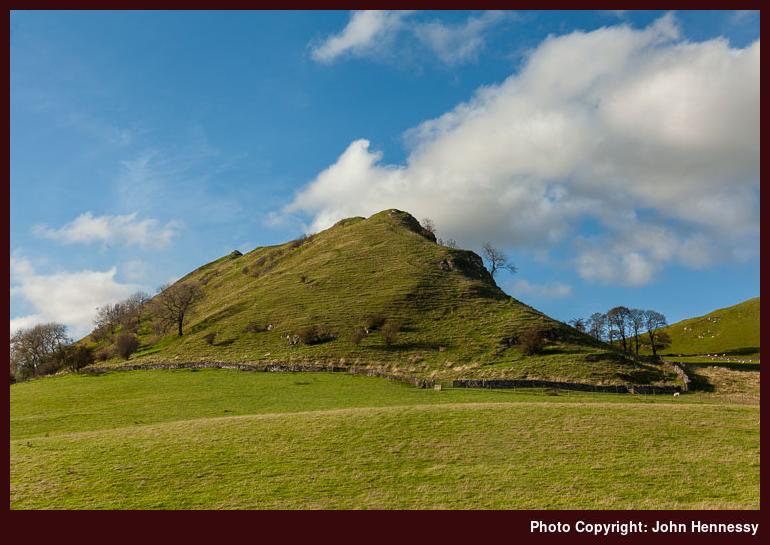
From Earl Sterndale, a public footpath led me through fields around Hitter Hill before dropping me onto the B5053 near Glutton Bridge after I had deliberated on the supposed line of the public footpath give that a farmhouse lying just beneath me. This was to be repeated later, but the next part of my route was easily clear. Deciding against any ascents, I passed Parkhouse Hill instead of ascending it. This was to be a time for getting to know the area better after passing by on several bus journeys and seeing photos in magazines. Any hill climbing could wait and there were photos to be made.
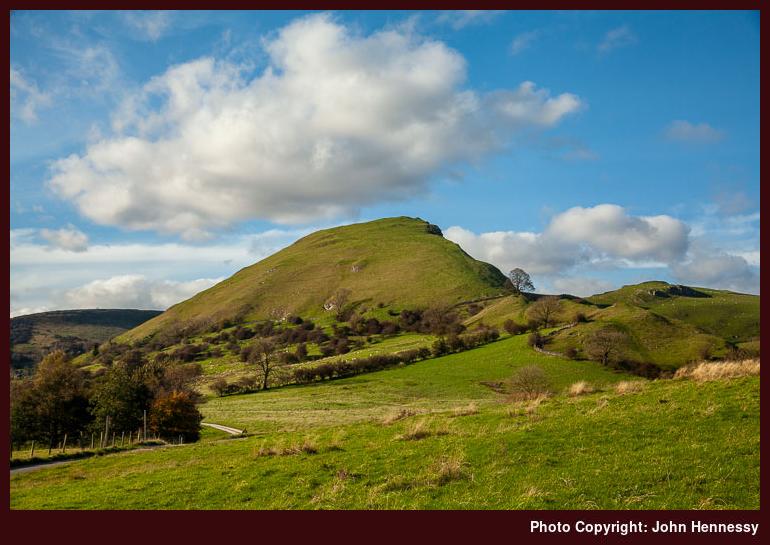
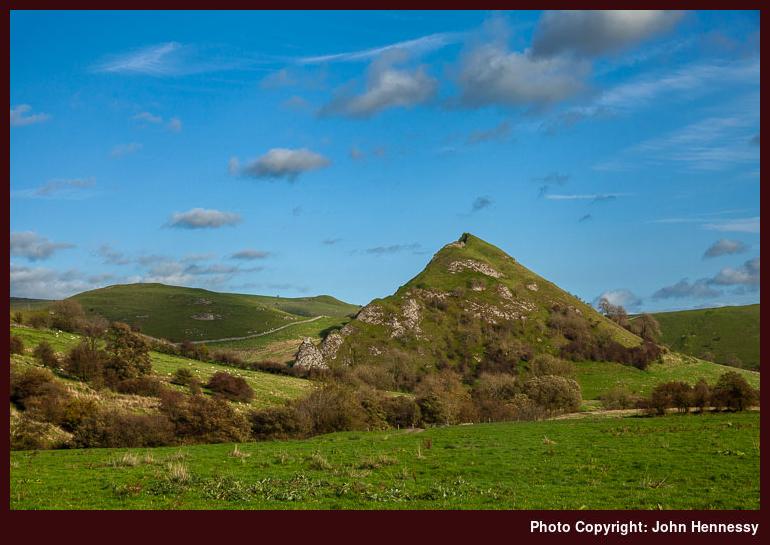
The path rounding Parkhouse Hill deposited me on a lane that I soon left to follow a byway that took me past Chrome Hill. The theme of passing hills rather than reaching their summits was continuing with encouragement being provided by a lunchtime start and the loss of evening light. Accompanying quietude allowing for stilling of the spirit, admiration of surroundings and ambience together with a chance for my brain to drift while I made for Hollinsclough.
That again was a quiet hamlet and I left it to head for Booth Farm along clear paths and tracks. Deciding how to continue after that took some thinking and not a little courage to work out the correct way to Thirkelow. Once I had done that deed, there still was a chance of veering off trail and it took my GPS receiver to stop me going towards Brand End. Earlier fears about such imperfections arousing the ire of landowners were unrealised and another encounter with the effects of industrialisation lay ahead of me.
The last stretch of my amble took me around land owned by the Health & Safety Laboratory with attendant signage to stop any wandering into danger zones where experiments get conducted. The floor of the defunct Stanley Moor Reservoir was another perilous place to avoid and that was passed without much in the way of inspection as I continued towards Buxton Country Park, whose environs ensure a far more amenable feel to the end of my stroll. All was again familiar as I went from there to the nearest bus stop to await the last bus of the day from Buxton to Macclesfield, a feat that was achieved with minutes to spare, so a satisfying day could be reviewed on the way home.
February 2019
As described in another post, the spring of 2019 saw such a frenzy of wandering about England and Scotland that it was very different to autumn 2017 when I was replenishing my energy reserves. Near the start of this outbreak of outings, I returned to Earl Sterndale for a walk close to home in advance of a trip to Ireland.
Looking back through this trip’s photos now, it surprised me how long I spent in Buxton before travelling to the starting point for the day’s ramble. The morning was sunny and mild so it might have been inevitable that I made the most of the layover time. In fact, the weather was to remain like that for the whole day.
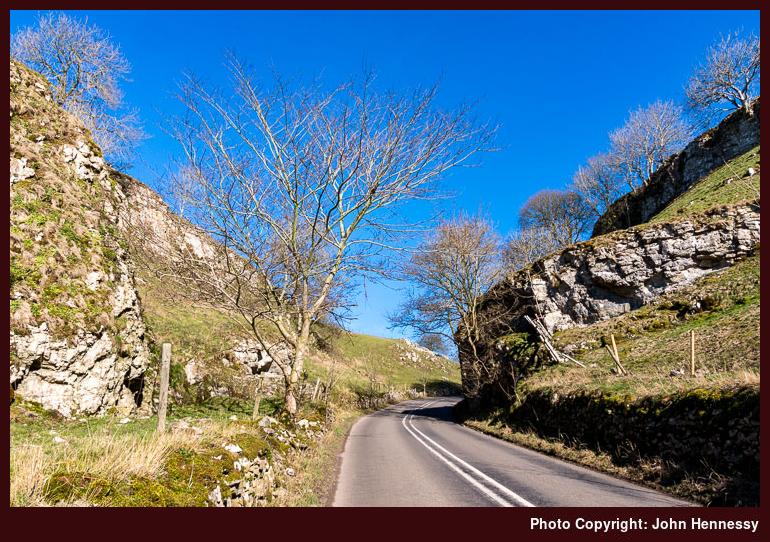
It also was to be one with many variations on the route followed in October 2017. The first of these decided the first stretch of my ramble once I arrived in Earl Sterndale. The re-use of the public footpath from the previous walk would have been expected but I instead chose a way that added road walking involving the B5053 and that gained the sight of Glutton Dale, which looked similar to many a Derbyshire dale that I have encountered apart from its having a tarmacadam road going through it.
The reason for this is lost to me now if there ever was one but I do recall the dismissal of the idea of using a right of way from Glutton Grange because the person who was using it was not a walker like myself but looked more like someone of farming stock. Maybe it was my shyness that intervened but it was to be a day when such decisions recurred even if more outdoors enthusiasts like myself were around.
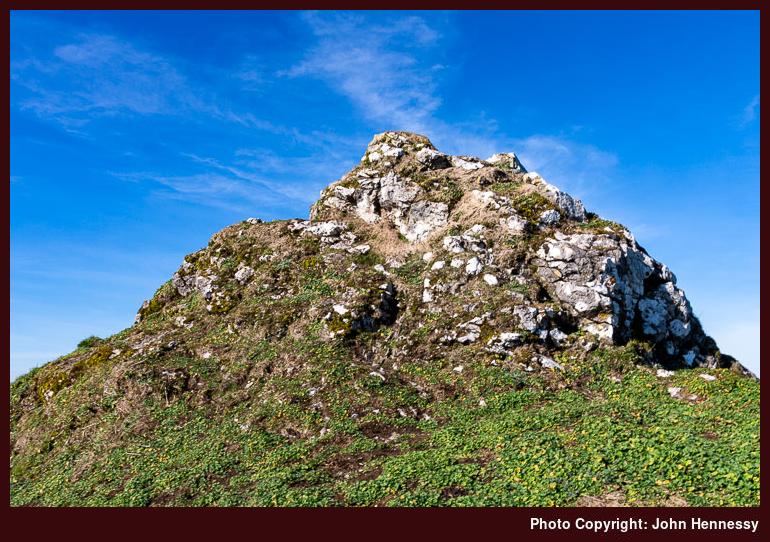
On the approach to Parkhouse Hill, there were figures seen to be ascending its southern slopes. When I left the B50553 for a path leading towards it, they were gone and it could be presumed that they had completed a traverse of the steep-sided rocky little hillock. As it happened, I too was to follow in their wake and reached the top of the hill before deciding to change my route again.
The height gain may have not been that much but the combination of steep ground and a sense of pronounced exposure was enough to cause me to retrace my steps from the summit instead of dropping down through the rocky pinnacles. Doing so needed an element of fortitude but I soon enough found another way: along the hill’s eastern slopes a gentler descent was on offer and it led me north as I wished. As other walkers continued up the hill with their dog, I used this quieter easier terrain to both continue on my way and regain my composure.
Once down on the lane again, I was to see where the northbound descent led and decided that I had chosen a more sensible route. Because Parkhouse Hill is on Access Land, doubts about footpath maintenance also surfaced. The last thing that anyone needs on steep exposed ground is an eroded path that offers reduced traction and I have met a few of those on my ambles. Another summit lay ahead of me so it was better to have saved myself for that.
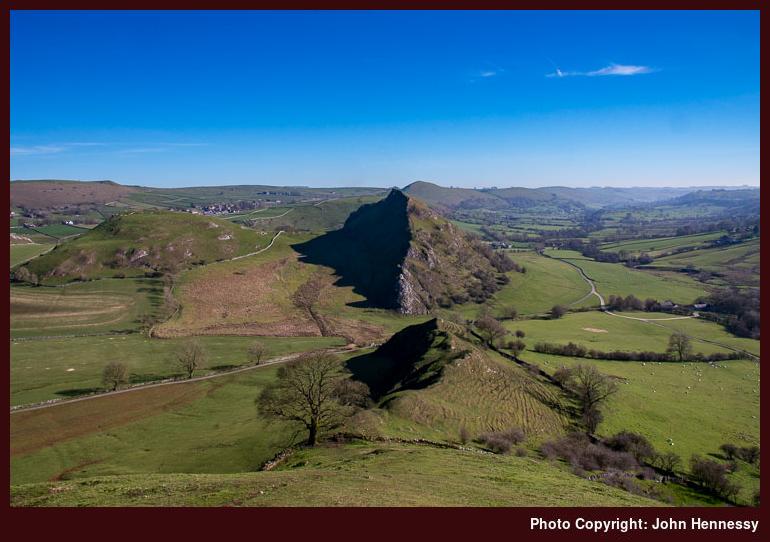
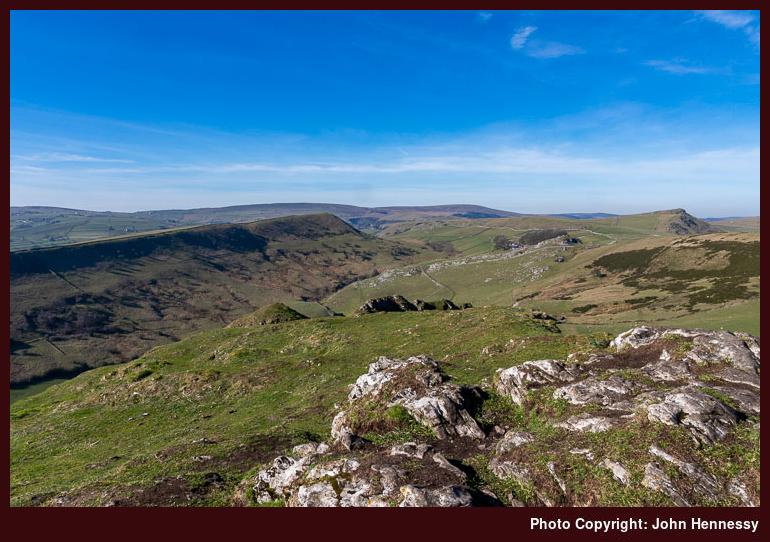
Once down on the lane separating Parkhouse Hill from Chrome Hill, there was time for a little refreshment before I sought out the concessionary path leading onto the Access Land encompassing the latter. Before that, a Land Rover driver stopped to ask me if I had a parked car. Having none, the conversation came to an end there and I recommenced my walk.
The way up the southern flank of Chrome Hill was a more friendly affair compared to that of its neighbour. The greater girth had something to do with that and that was just as well given the higher summit. Though I might have been tempted to continue north from there, the lack of a right of access, let alone a right of way, put a stop to that. The later sighting of a fire demonstrated the wisdom of ascending and descending the hill by the same route.
On returning to the lane, I now reprised the one part of the pair of walks that was identical in each: the section from the feet of Parkhouse Hill and Chrome Hill to Booth Farm via Hollinsclough. Along the way, smoke from that fire on the northern slopes of Chrome was there for all to see. It even caused some fellow ramblers to ask me if I had been on Chrome Hill and if it was alright. In fact, I had seen no sign of a fire while up there savouring unobstructed views of what lay all around me.
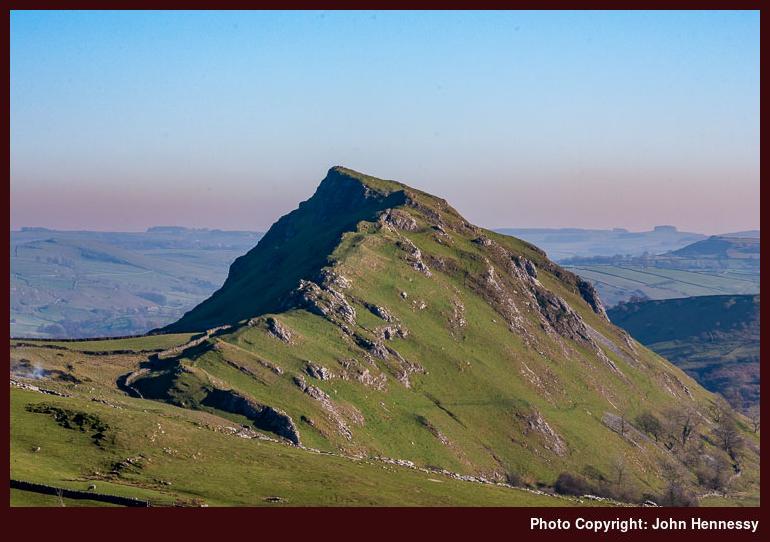
At Booth Farm, the passage of time between encounters ensure the lack of confidence away where a right of way led and the extra activity on the day led me to dismiss the previous route to Buxton in favour of following a lane before leaving it for a more distinct public footpath. Along the way, I could look back towards Chrome Hill with any fire near there by now a smouldering remnant. My sense is that this might have been controlled burning, as dramatic as it looked, but I know no more.
Still following public rights of way, I continued from field to field and across Access Land encompassing High Edge. From there, I dropped down by Staker Hill and found my way onto the road leading to Harpur Hill on the outskirts of Buxton. That was preceded by my traipsing through what might have been someone’s yard, but there was no associated rancour and I ambled along the road for a while before choosing to await a bus at a nearby bus stop. The walk had ended in time to allow preparation for travelling the next morning and the day had brought much satisfaction. It had been a worthwhile second visit to an alluring area.
Travel Arrangements
Both walks saw me making use of service 58 between Macclesfield and Buxton. The 2017 outing saw me use service 441 between Buxton and Sterndale Moor while the 2019 one saw me travel from Buxton to Earl Sterndale on service 442. The latter also involved my using the TransPeak service to get from near Brierlow Bar into Buxton when a variation of the original route presented the possibility of more road walking than was desirable.
Echoes of repetition
1st March 2019There are times when trip ideas get re-used. The unseasonal sunny weather that dominated the second week of February became a backdrop to some of this. Firstly, it lured me up to Great Ayton for a day spent around Roseberry Topping, Highcliffe Nab and Easby Moor. This was a variation of a route enjoyed more than a year earlier when snow and ice were dominant. Then, the ground conditions added a need for extra care that probably should have precluded an ascent of Roseberry Topping that was facilitated far better in conditions more typical of late spring or early summer.
A few days later, I was drawn to Earl Sterndale for a walk that took in the tops of both Parkhouse Hill and Chrome Hill. The latter was more friendly to those whose tolerance of exposure is more limited. Some might go up and over the former but I did an out and back trip to its summit before kinder gradients were descended in a northward direction. In the autumn of 2017, I had passed both on the way from Sterndale Moor to Buxton but avoided their summits on that equally pleasant sunny day.
Sometimes, there are stronger patterns of repetition there is one shared between 2010 and 2017. Both featured trips to Sweden and Aberdeenshire as well as marking the start and end of my time with a single employer. Because of the changeover in employment arrangements, the destination pairing has a certain eerie resonance for me.
Neither the Swedish or Aberdeen trips were my first to either place but it took a third visit to the former for more of a leisure focus to show itself. September 1997 saw my first visit to Aberdeen and that was for a scientific congress while business was the main motivation for those first two trips to Sweden. Even so, there opportunities for personal exploration offer themselves too because conferences cannot occupy you for all their duration and long sunny Swedish summer evenings made for pleasant strolling around both Södertälje and Stockholm.
The 2010 sojourn in Aberdeen allowed for more city strolling and a visit to Braemar only months after starting a new job. There was no mountain walking in 2017 but Stonehaven, Dunnottar Castle, Banchory, Crathes Castle and the Deeside Way more than occupied the time not spent on city wanderings. In fact, the idea of doing some castle visiting was a seed sown during the previous trip. That it preceded my leaving the company that I joined in 2017 by a matter of months made it a kind of a bookend to my time there.
One of the motivations for heading to Aberdeen for the 2017 Spring Bank Holiday weekend was as a means of dealing with the fact that I no longer enjoyed working where I was. Together with a second trip to Norway, it was intended to salve the lack of enthusiasm that I had for what I was doing but it was not to be a long term strategy so I made the difficult decision to leave my then employer and take a career break while I worked through the aftermath of a number of life events as well as working out what my future career direction might be.
It was after starting the career break, that I then headed to Stockholm for an extended weekend stay. My previous time in Sweden preceded a departure from a then current employer and information transfer was its purpose. Only weeks later, I was going to start with the employer that I left in 2017 so there was a curious symmetry about my actions. Naturally, city explorations were to follow with even Gothenburg receiving a fleeting visit. Tyresta National Park became the starting point for the longest hike that I enjoyed while in the country. The whole experience was vastly more restive than the preceding months and it would take more than a year before I started to explore places beyond British and Irish shores.
If I have my way, such juxtapositions as pairings of trip destinations and career changes may not be repeated in the future. Though there are other places to see and experience, I also hope to continue my Scottish and Scandinavian encounters. My choice would be that they do not need career upheavals to make them happen because we need to keep making more happy memories to get us through times that are more testing.